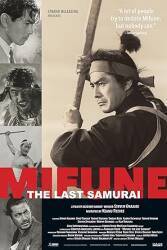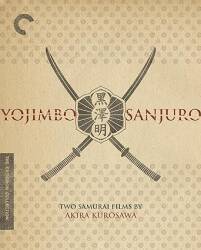
Views of Nagasaki Harbor from Kazagashira Park
Great Views on a Sunny Day
Arrival inNagasaki
I had
arrived in Nagasaki
on a dark and wet day.
The weather was completely different the next morning.
Bright and sunny!
I climbed the hill to Kazagashira Park, following the
Samurai Path through a cemetery.
There are great views over parts of the city and the harbor.
Later in the day I walked down to the harbor.
Starting up the Hill
When I arrived the previous afternoon, I could only see about a block up the side streets. There was fog and mist in the air, and the bottoms of the clouds were most of the way down the hill.
I was staying at the Akari Hostel, along the Nakashima River which empties into the harbor. Here I'm looking up the side streets the next day. What a difference!
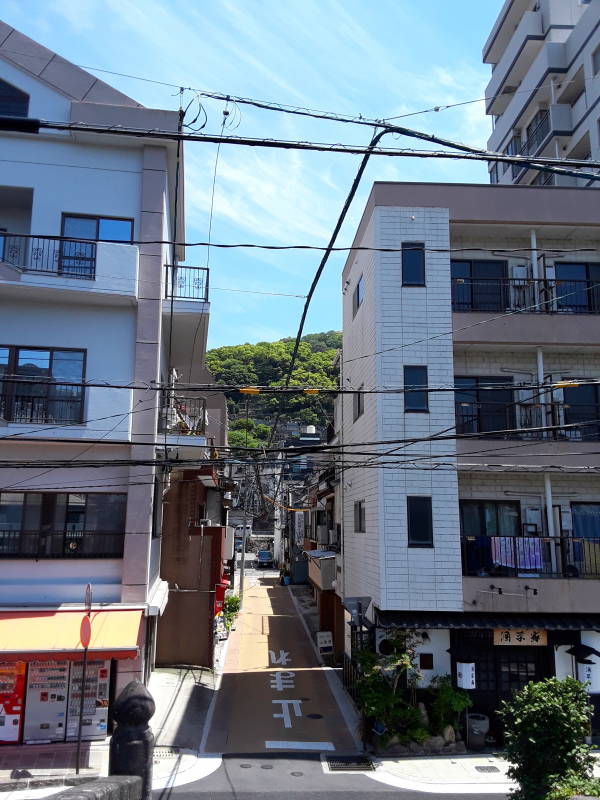
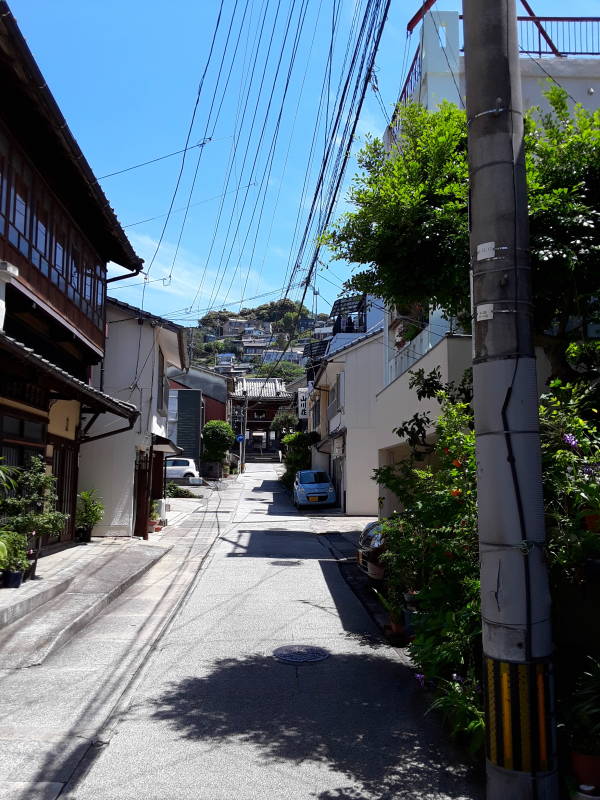
At the end of this side street I will pass Jinso-ji, a Jōdo-shū or Pure Land Buddhist temple.
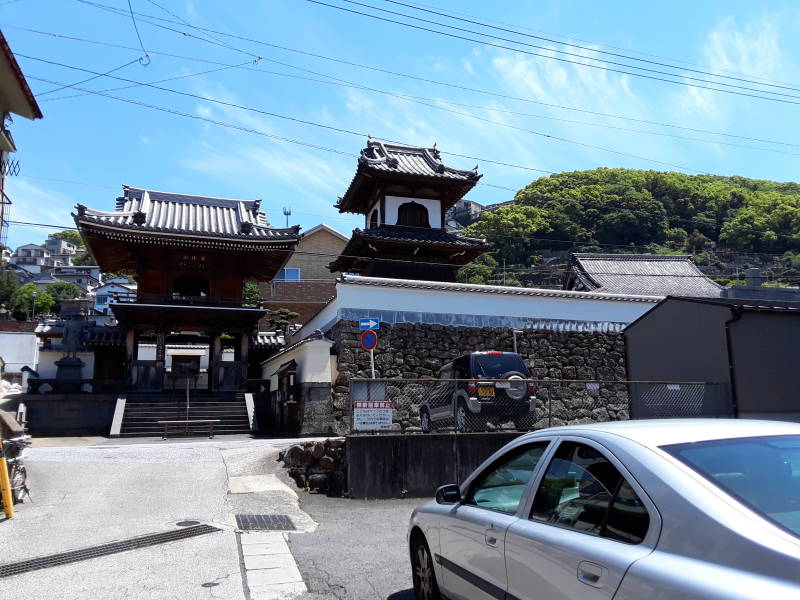
I'll go around the temple and follow the Samurai Path up the hill to Kazagashira Park. I'm going to the peak of the hill you see above and below.
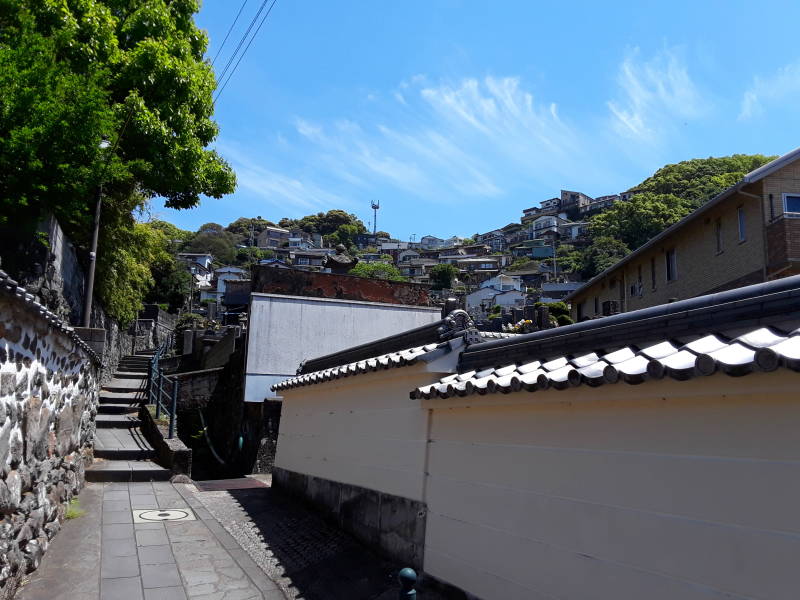
The path climbs along the north edge of a cemetery.
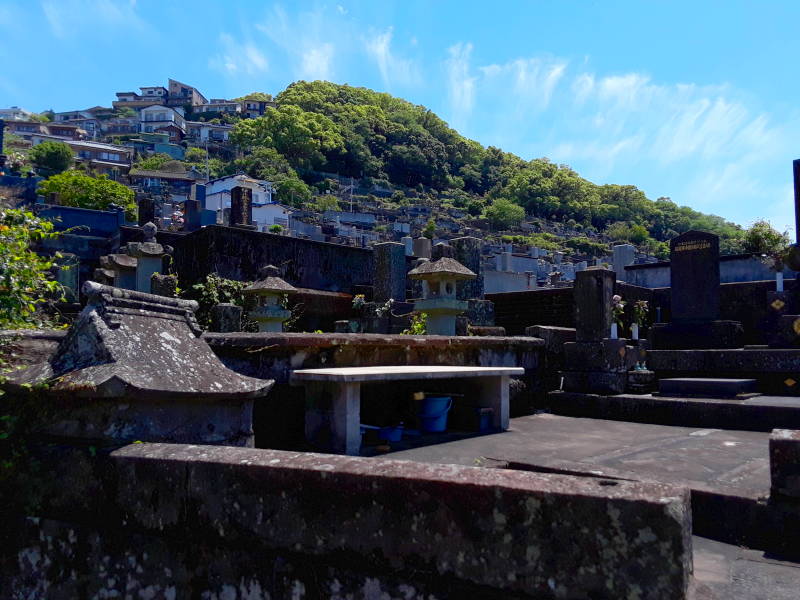
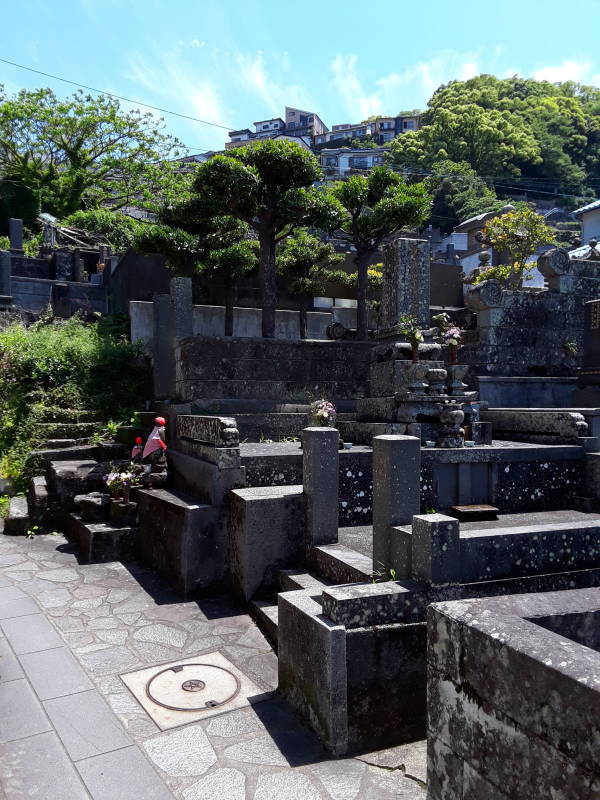
As you climb the path, it becomes more of a staircase. It's a 200 meter climb to the top.
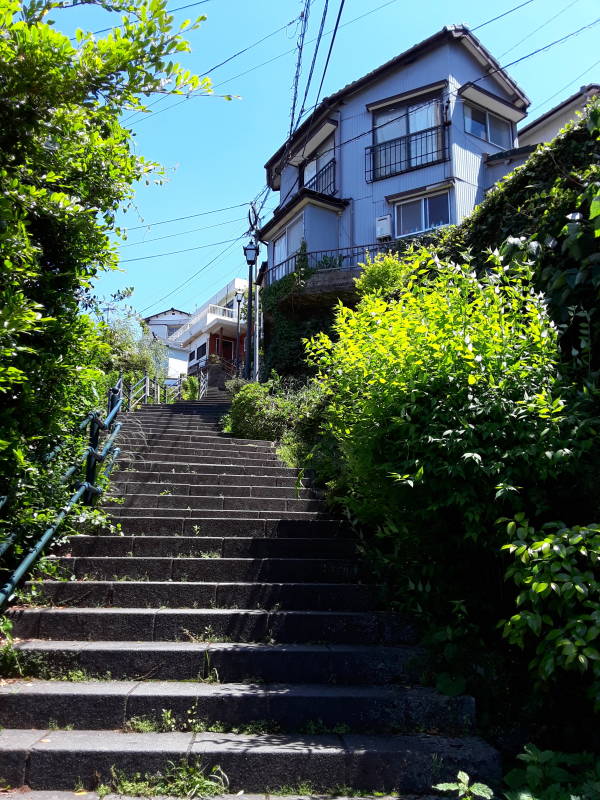

Sakamoto Ryōma
The path leads into narrow residential lanes in the Irabayashi district. To the south, you enter the park and find the statue of Sakamoto Ryōme.
Japanese myth says that Jimmu, the first Emperor, was the great-grandson of the grandson of Ameterasu, the sun goddess, and Susano-o no Mikoto, the storm god. They created the universe, and the Imperial House of Japan has been one long unbroken line of descent, or so the story goes.
Kyōto NaraThe Emperor stayed in and around the Imperial Palace outside today's Nara, and then moved to the new capital of Kyōto. The Emperor had ceremonies to perform to maintain the universe, and other distractions in the Imperial capital. Feudal warlords gained temporal power across the territory of Japan.
The chief of all the warlords came to be called Sei-i Taishōgun or "Commander-in-Chief of the Expeditionary Force Against the Barbarians". Or just Shōgun for short.
The Shōgunate, with one top military leader ruling Japan, lasted from 1185 to 1868. The Shōgun was nominally appointed by the Emperor, but it was usually little more than a formality with the Emperor agreeing to accept the clan's leader.
Different clans controlled the position over the centuries. Tokugawa Ieyasu ended the Sengoku period of civil wars with his victory at the Battle of Sekigahara, and established the Tokugawa Shōgunate in 1600.
The Tokugawa shōguns made their capital at Edo, formerly a small fishing village. Japan cut itself off from the world. Edo grew into a sophisticated city. Then U.S. Navy captain Matthew Perry led an expedition to Edo in 1853, and coerced Japan into opening its ports to trade.
Enormous changes occurred from 1853 to 1868. In 1868 the Emperor returned to power as the Meiji Restoration ended the shōgunate and gave all power to the Emperor. The Emperor moved to Edo, which was renamed Tōkyō.
Sakamoto Ryōmo was a samurai and a prominent figure in the Meiji Restoration. He opposed the shōgunate, and advocated the return of power to the Emperor, but also democracy, industrialization, and modernization in general. He was assassinated in 1867, just before the Meiji Restoration. A statue of him is near the peak, looking out over the harbor.
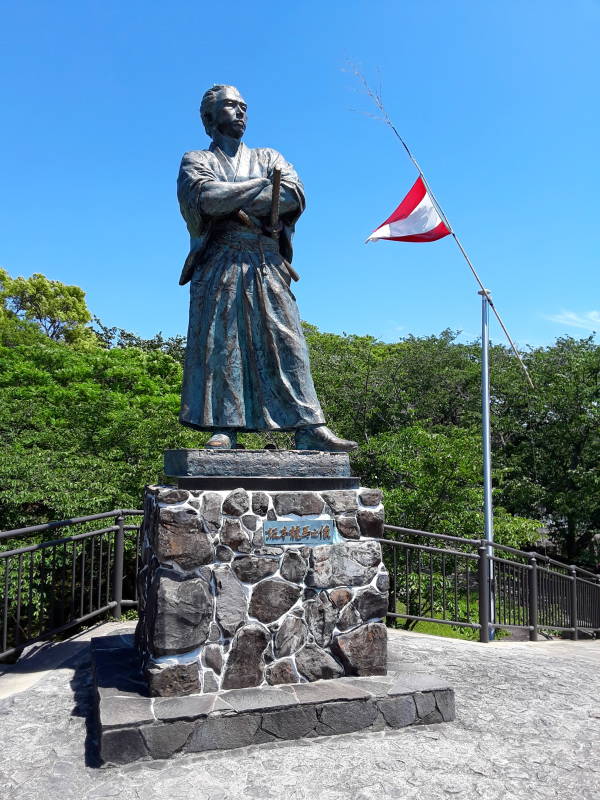
Ryōma was teaching swordsmanship in Edo when Perry's fleet arrived. The Tokugawa shōgun's agreement to Perry's demands was seen as weakness. The Emperor, in Kyōto, had opposed the treaty.
Ryōma and many other samurai concluded that the Shōgun was no longer able to carry out the Emperor's will, and therefore no longer qualified to rule the nation. They supported returning state power to the Emperor, and began agitating to overthrow the Shōgunate.
In 1858 Ryōma had finished his studies in Edo. He returned home and became active in the local anti-Tokugawa movement. He had studied democratic principles and governance, and admired the U.S. Congress and British Parliament as models for the governance of Japan after the restoration of the Emperor.
He had also studied industrialization, regulation of exchange rates for gold and silver, and the formation of a modern national army and navy. Many today regard him as the "father of the Imperial Japanese Navy".
Ryōma was assassinated in December 1867, shortly before the Meiji Restoration, at the Ōmiya Inn in Kyōto. A group of assassins was gathered near the outer door, and one knocked and pretended to be an ordinary caller. Ryōma's bodyguard and manservant, a former sumo wrestler, answered the door and was the first to die. Ryōma and a traveling companion were both severely wounded, and he died later that night.
Views from the Park
Here is the view to the northeast, over a residential district and on to higher peaks.
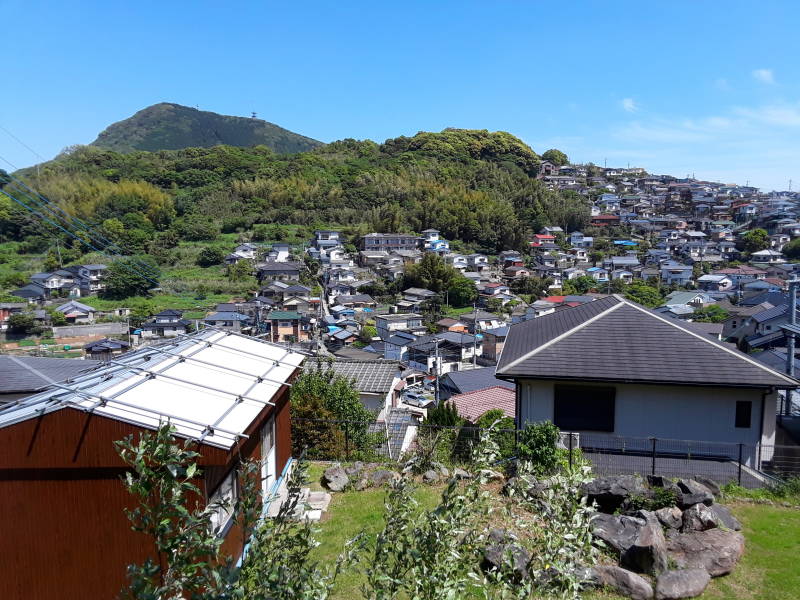
Turning to the left and looking north from the highest viewing point, we see the valley extending out of Nagasaki. The relatively small Nakashima River flows down this valley to the harbor.
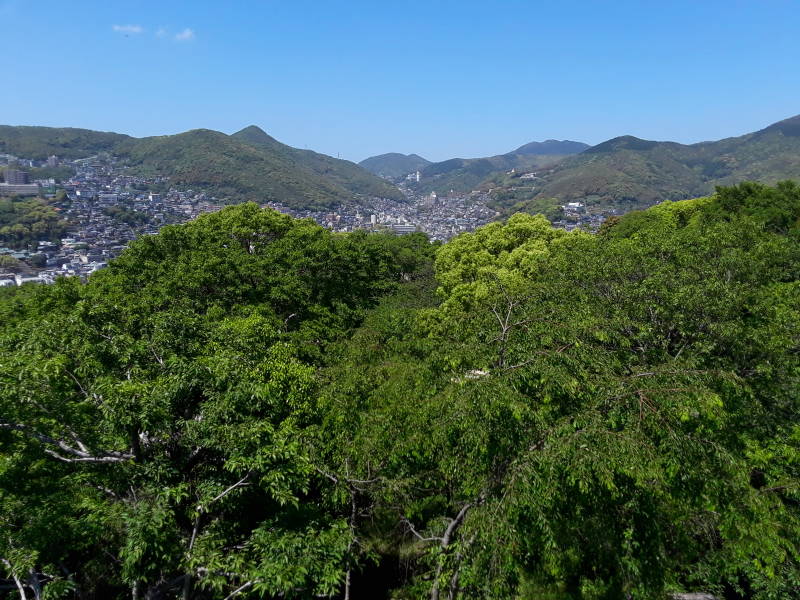
Further to our left, looking northwest, we see Mount Tamazono-san, the ridge dividing this valley from the one with the larger Uragami river and the rail line.
The nuclear bomb was dropped 3.4 kilometers up that valley, on the other side of that ridge which largely protected this valley.

Turning further to our left, looking west, we see the innermost extent of the harbor. The two light green spherical tanks are just north of the train station.
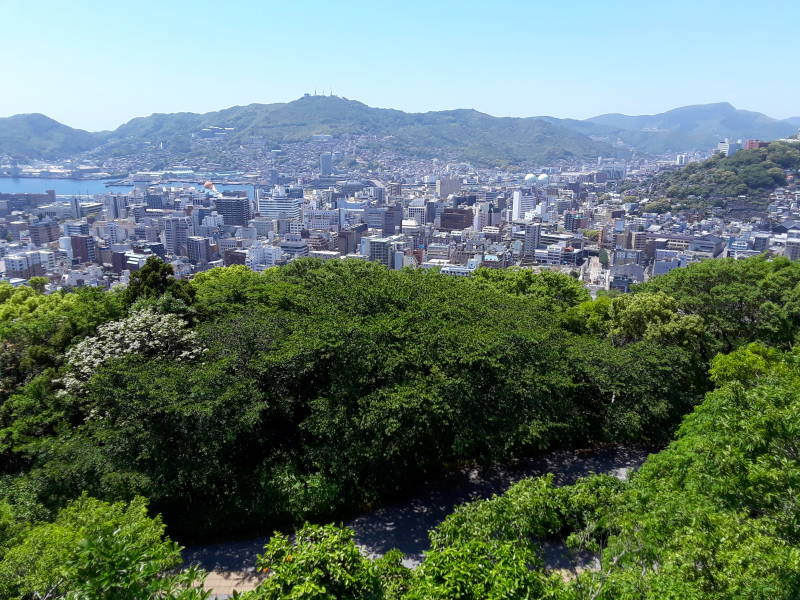
Further to our left, looking southwest, we see what a phenomenal natural harbor this is. A large cruise ship is in port on this side. Large cargo facilities line the far side.
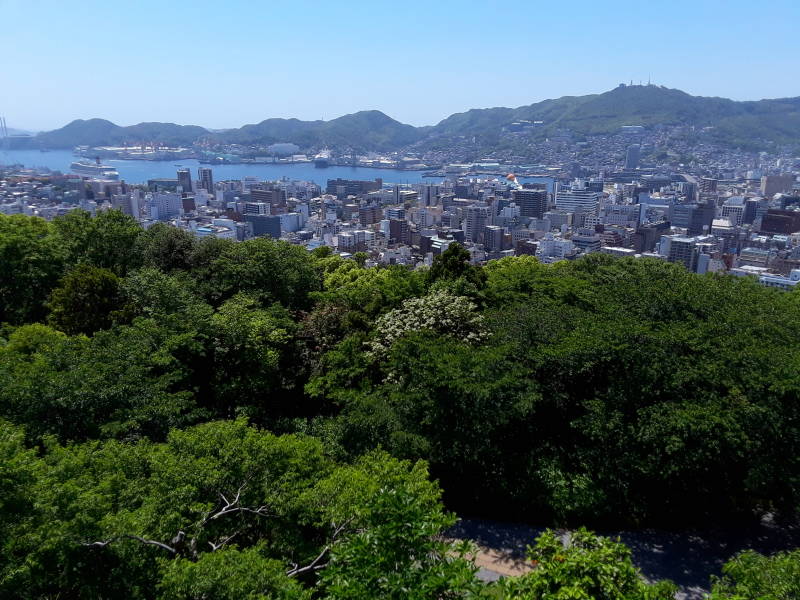
The Megami Bridge spanning the harbor opening was finished in 2006. Its main span is 480 meters between the towers, with 65 meters clearance above the water.
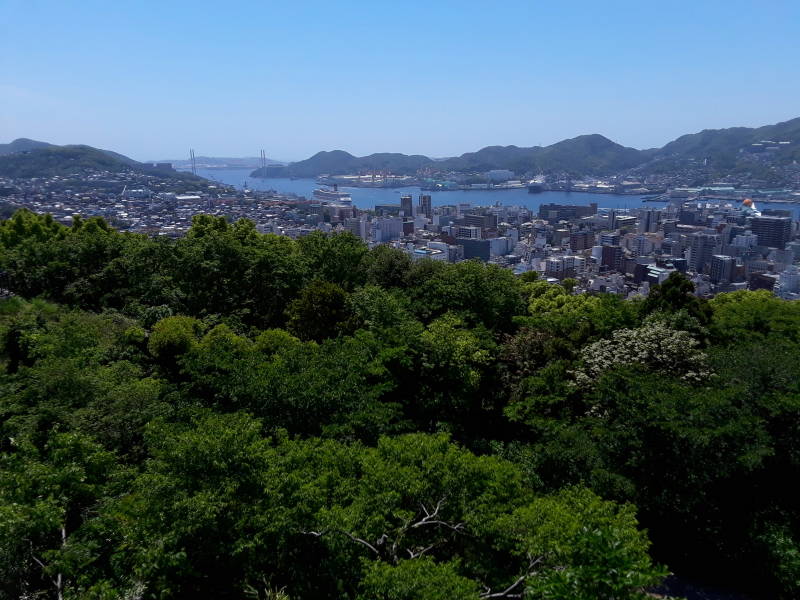
There's Sakamoto Ryōma's statue. As the "father of the Imperial Japanese Navy", it makes sense for his statue to be here.
Nagasaki was a major Imperial Japanese Navy base during the First Sino-Japanese War of 1894-1895 and the Russo-Japanese War of 1904-1905. Before and during World War II, Sasebo, the next major port up the Kyūshū coast, was the regional naval base. Nagasaki concentrated on building ships.
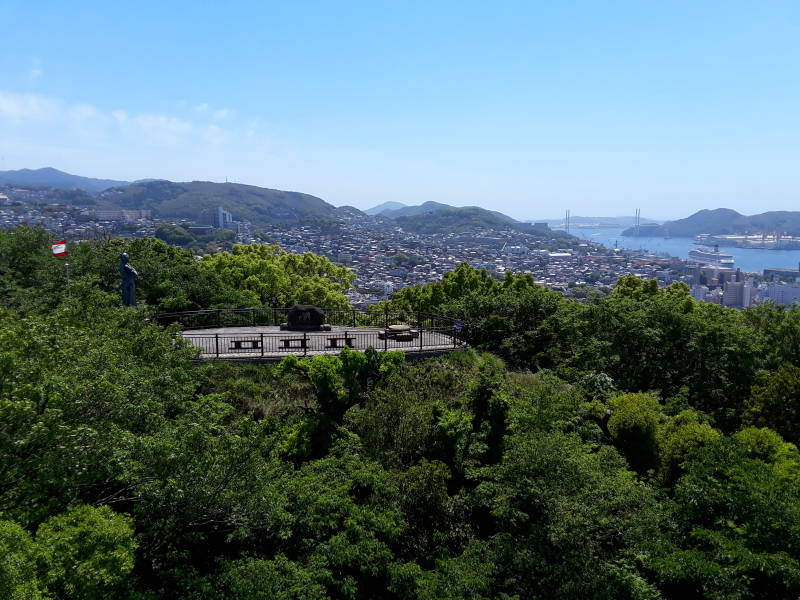
Down to the Harbor
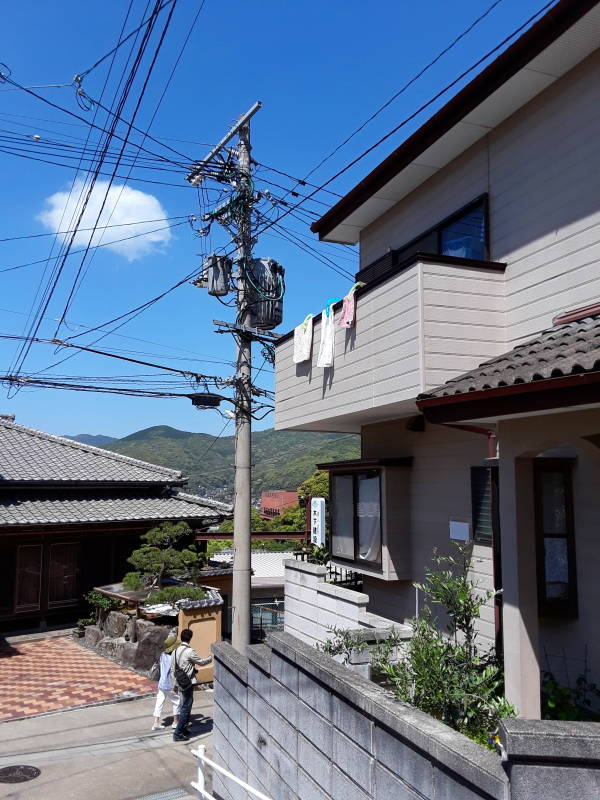
I'm heading back down the hill, going to the waterfront.
Electrical power lines are always visible for easy inspection in Japan. Especially so from that balcony.
I'm back on the Samurai Path, starting past the cemetery on my way back down.
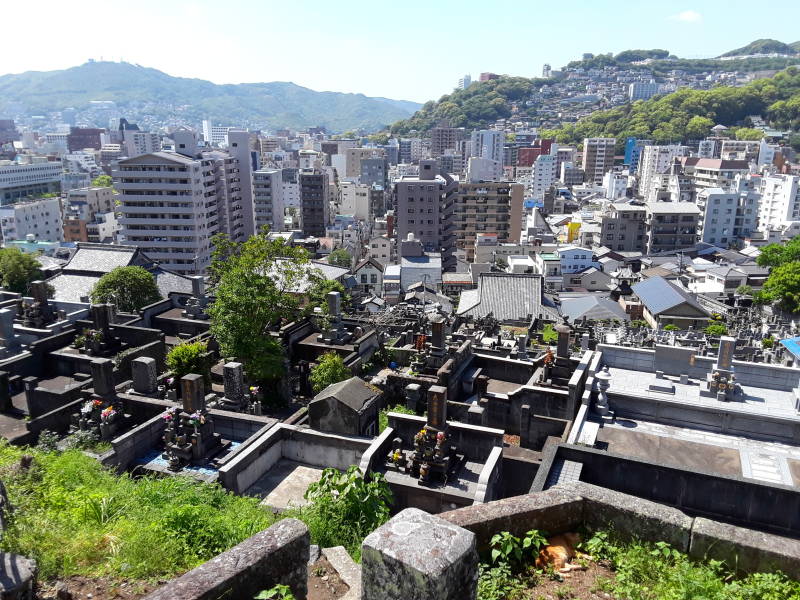
At the Harbor
Here's a relatively small cargo ship, a ro-ro or roll-on/roll-off ship. Trucks are driven on and off as if it were simply an oversized ferry. It's a Goto ro-ro.
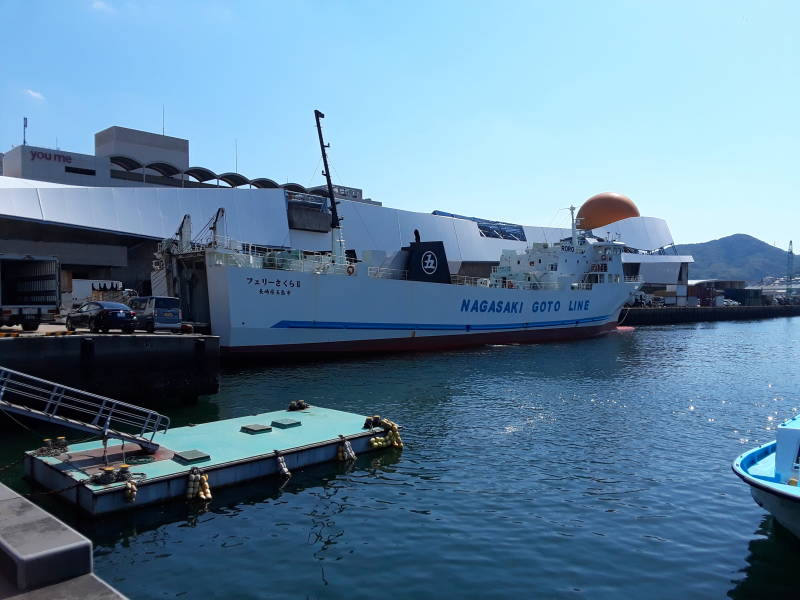
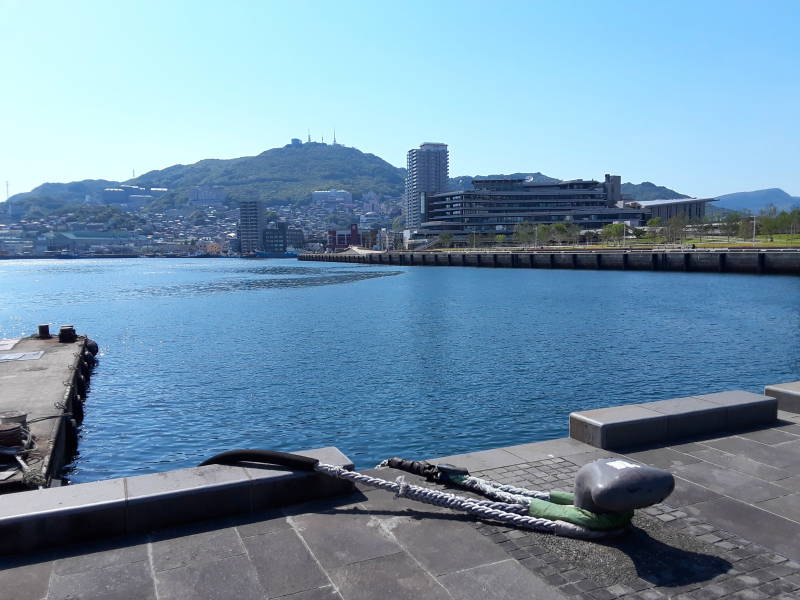
This is the view south through the harbor toward the ocean.
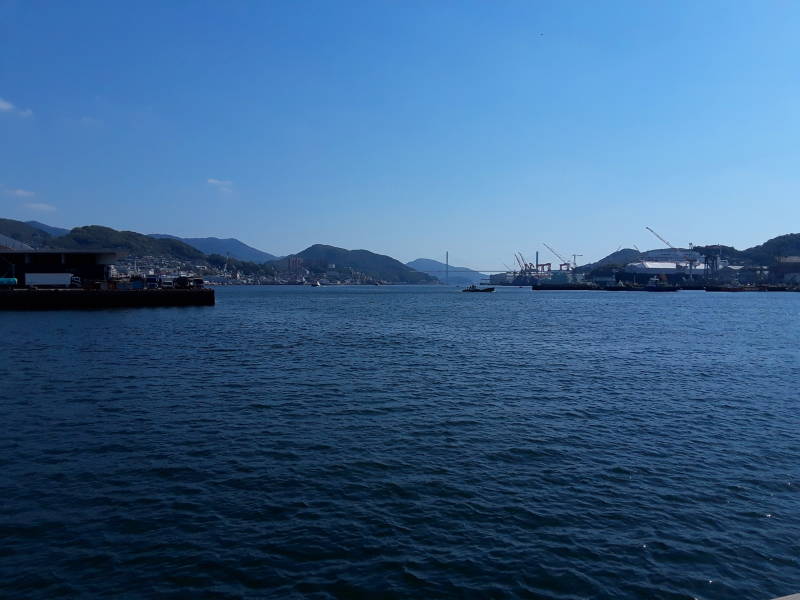
There are several cafés along the east side of the harbor.

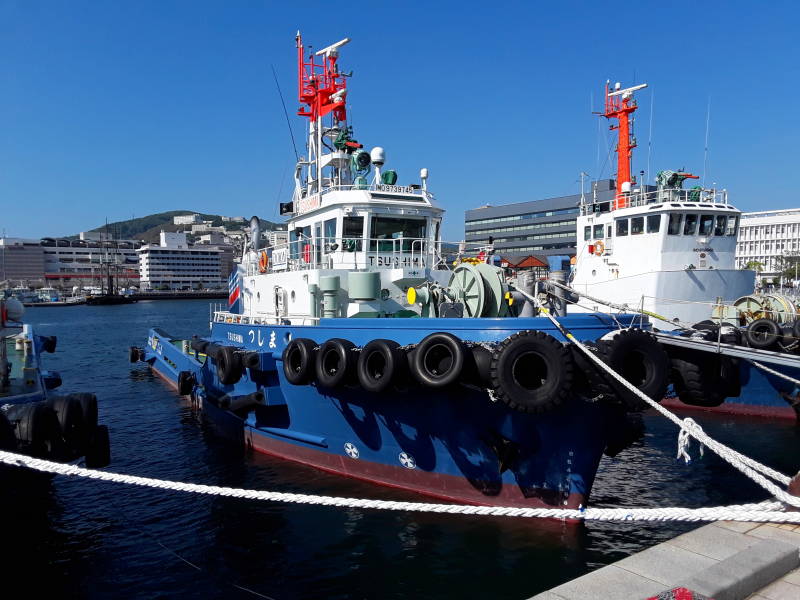
Tugboats are ready to help ships in and out of the harbor.
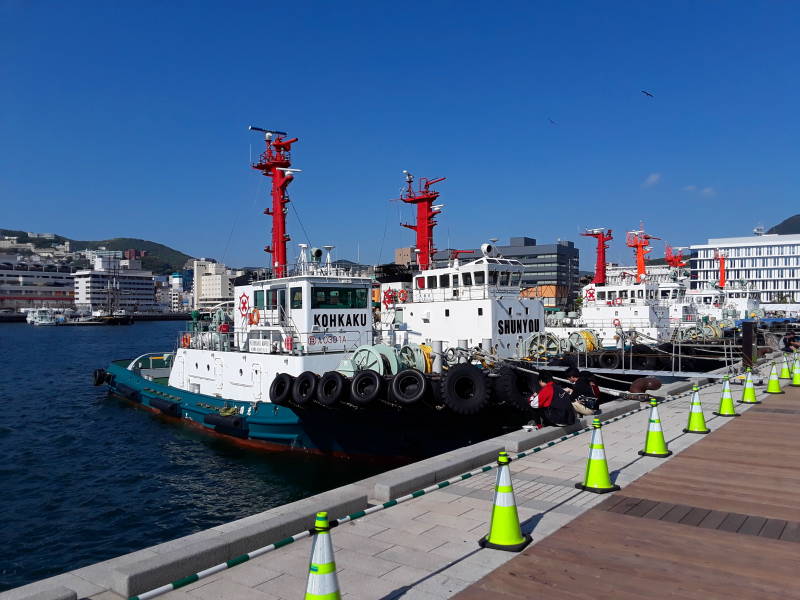
It was still Golden Week, the celebration of the birthday of Hirohito, now known as the Shōwa Emperor. It's the biggest holiday in Japan.
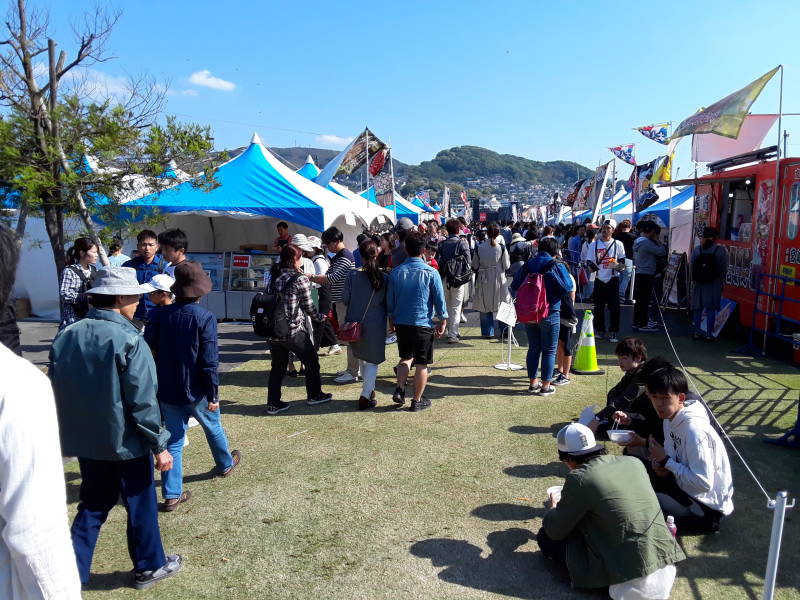
Music, and many food stands.
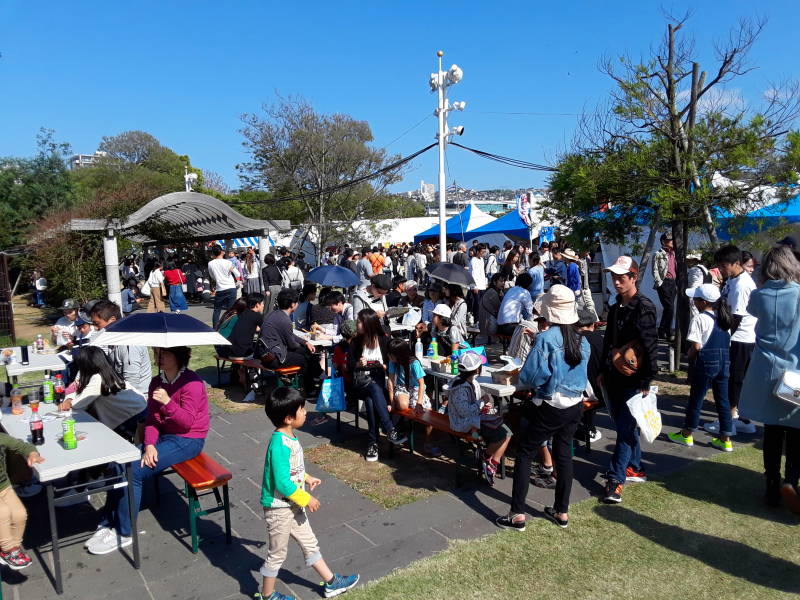
The west side of the harbor now hosts the main cargo operation, along with shipbuilding.
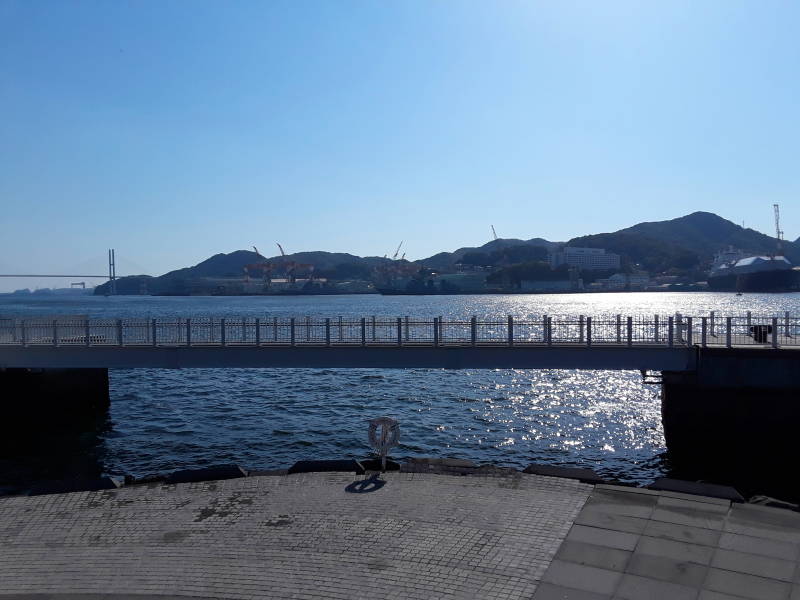
Barely visible in the glare are JMSDF guided missile destroyers DDG-173 and DDG-178, the JS Kongō and JS Ashigara, respectively.
Return to the Harbor
I was back at the harbor on a lightly overcast day with better visibility across to the cargo side.
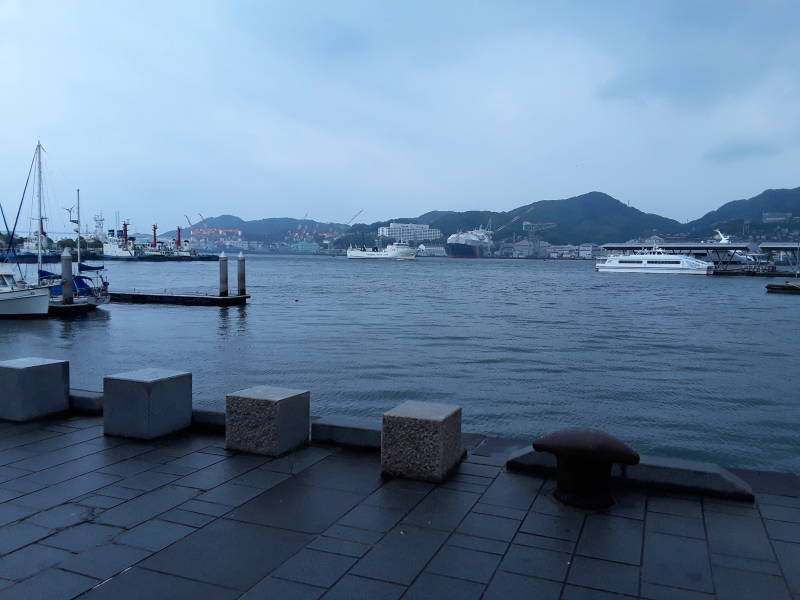
it now?
The big ship on the opposite side of the harbor is the Diamond Gas Orchid. It was just then being finished in the Mitsubishi Heavy Industries shipyard. It's an LNG or liquified natural gas carrier, transporting fuel out of Louisiana. Natural gas is mostly methane, CH4, with some ethane, C2H6. Kept below –162 °C, it remains a liquid. It's stored in large roughly spherical tanks. The tanks have heavy insulation, but 0.1–0.25% of the cargo vaporizes every day on a typical journey. That boil-off is used as fuel for the engines. The Diamond Gas Orchid is 293.5 meters long and 49 meter beam, with 165,000 cubic meter cargo tank capacity.
I'm having a late lunch of salmon donburi, miso soup, and pickled vegetables.
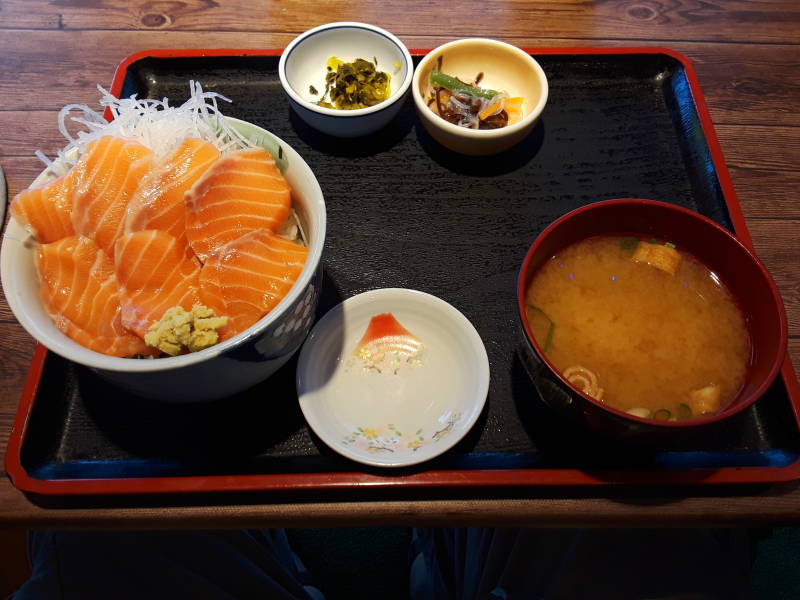
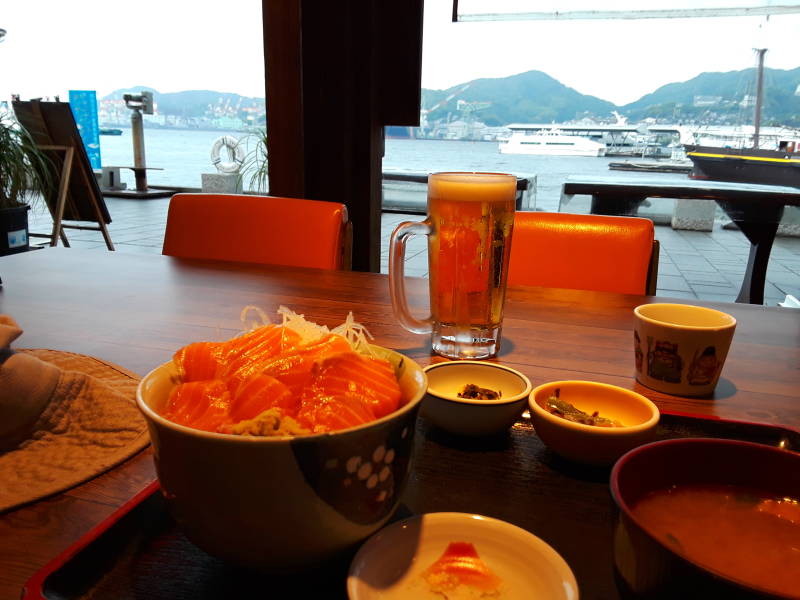
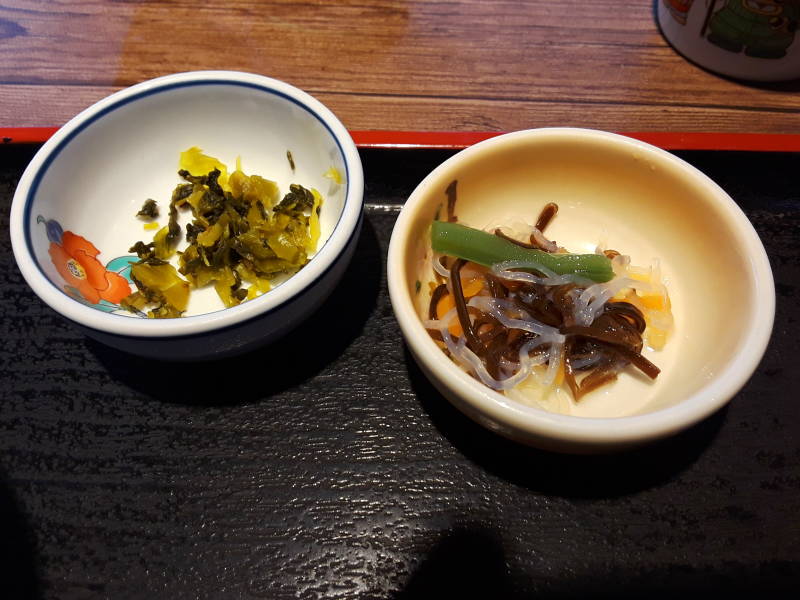
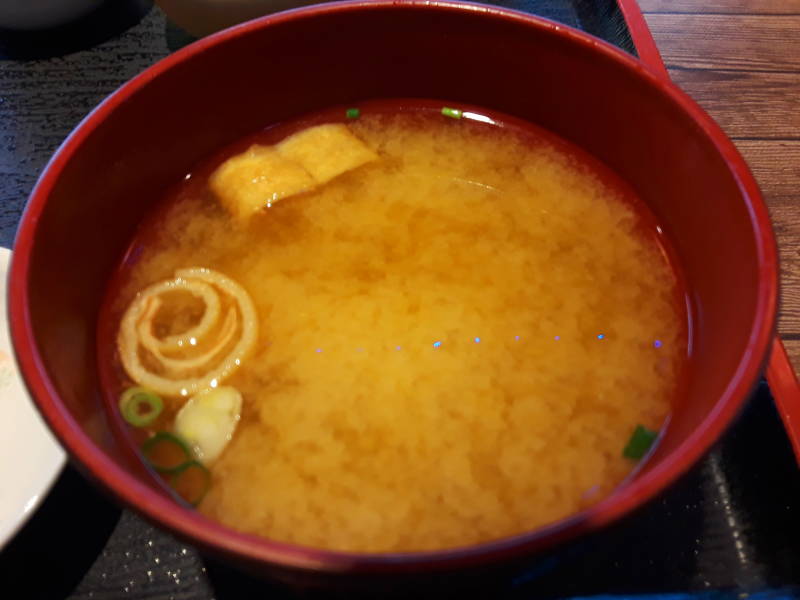
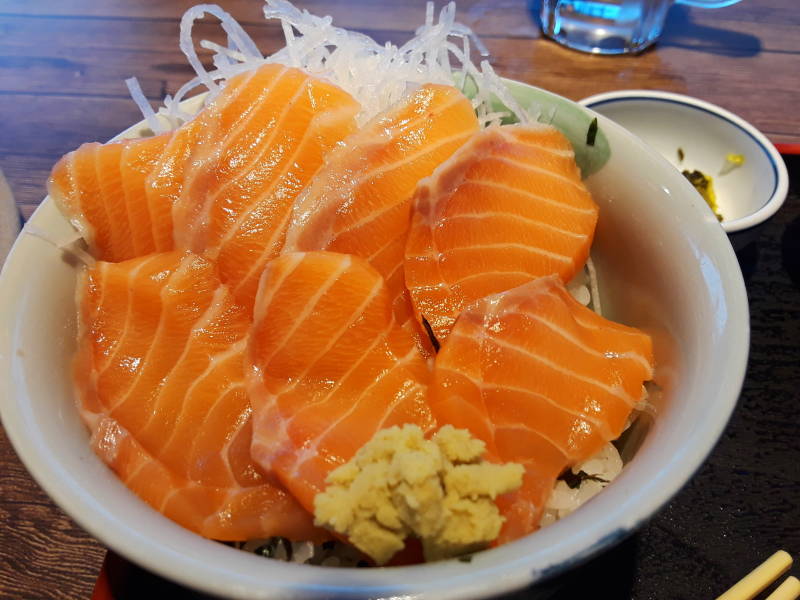
Dejima Island
Nagasaki was a small fishing village. Trade and political relations with China had ended due to piracy in the South China Sea. Portuguese explorers first arrived in 1543, and trading freighters soon began visiting. The Portuguese traders served as intermediaries between Japan and China.
Then the missionary Francis Xavier arrived in Kagoshima, South Kyūshū, in 1549. He started a program of Christian evangelization throughout Japan, then left for China in 1552 and soon died there. Meanwhile many Japanese daimyōs or warlords were converting to Christianity. The most prominent was Ōmura Sumitada.
Ōmura granted a permit in 1571 to a Jesuit missionary and a Portuguese Captain-Major for establishing a Portuguese port in Nagasaki. Nagasaki quickly grew into a diverse trading city. Ōmura and the Jesuit leader Alexandro Valignano turned control of the city over to the Jesuits to avoid its control by a non-Roman-Catholic daimyō. For a brief time after 1580, it was a Jesuit colony.
In 1587, Toyotomi Hideyoshi's campaign to unite all of Japan reached Kyūshū. He took control of the city and ordered that all missionaries be expelled. However, that order was mostly unenforced.
In 1596, the Spanish ship San Felipe wrecked off the coast of Shikoku. The ship was carrying Spanish Franciscan missionaries. Its pilot casually told Hideyoshi that Spain routinely sent missionaries as an advance wave of a military invasion, as had happened in the Americas.
Hideyoshi had twenty-six Christians crucified in Nagasaki. More missionaries continued to arrive. The Jesuits, Franciscans, and Augustinians were competing for control of Japan, as were the nations of Portugal and Spain.
Tokugawa Ieyasu took power in 1603, and he initially tolerated Roman Catholicism because many Catholic daimyōs had been his recent allies.
Tokugawa consolidated his power in 1614, officially banned Roman Catholicism, and ordered all missionaries to leave. Most of the Catholic daimyōs renounced the faith and forced their subjects to do so. The minority that would not left Japan for the Portuguese colony in Macau, the Spanish colony in Luzon in the Philippines, and Japantowns across Southeast Asia.
Dejima was a small artificial island, just 120×75 meters, built in Nagasaki bay. Some Portuguese traders had been allowed to stay in Nagasaki. Tokugawa Iemitsu, the new Shōgun, had the island built in 1634 and moved the Portuguese traders to it, restricting them to business interactions only.
Land reclamation long ago surrounded Dejima. It has recently been restored to some of its Tokugawa-era appearance. In the below picture we're looking across the Nakashima River, emptying into the harbor along Dejima's north shore. Water channels around its other sides are mostly filled in.
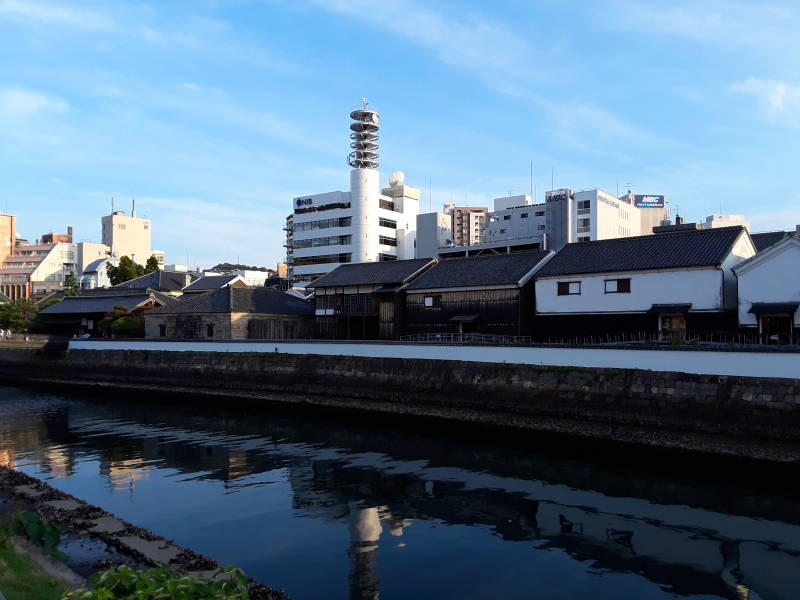
By 1639 Iemitsu was fed up with the Portuguese, and banished them. The Dutch had a trading base on the nearby Hirado island. The Shōgun moved them to Dejima.
Starting in 1641, only Dutch and Chinese ships were allowed to come to Japan, and could only land in Nagasaki harbor.
Below is the Old Dejima Seminary, dating from Portuguese use of the island. The Dutch were there strictly for business. Every ship was inspected, searched for religious items.
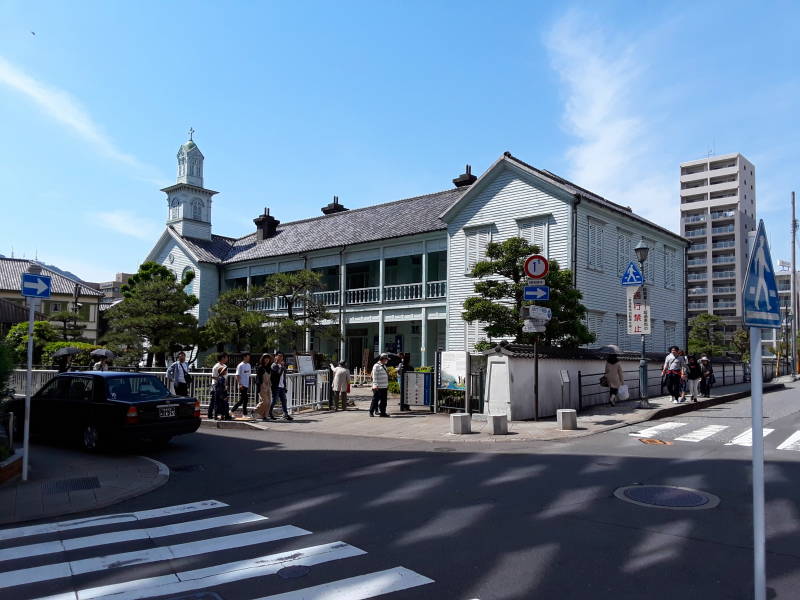
The ban on Dutch books outside Dejima was lifted in 1720. Hundreds of scholars came to Nagasaki for "Dutch Learning", the general term for European science.
When the Netherlands were under French Napoleonic rule in 1810–1813, this was the only place in the world where the Dutch flag flew.
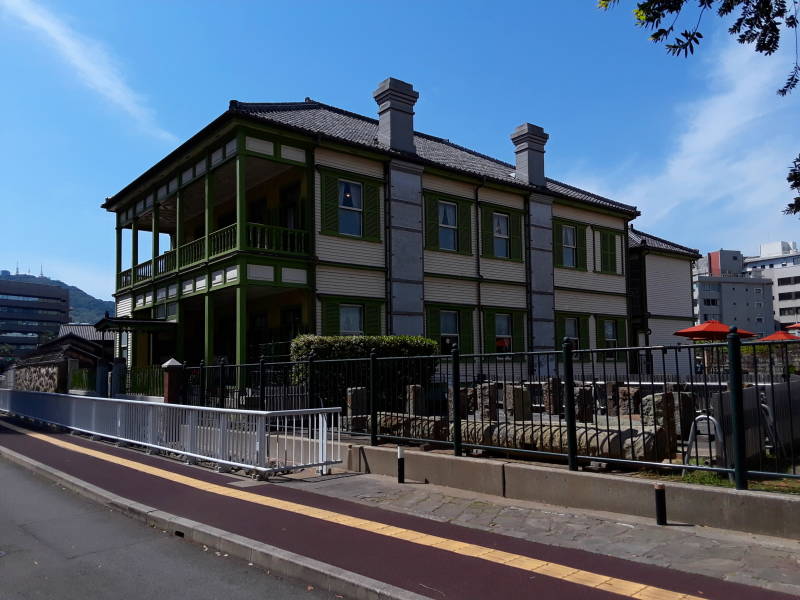
Japan's policy of isolation began loosening when Perry's initial expedition forced its way into Edo harbor. The Dutch physician Jan Karel van den Broek arrived in Nagasaki in that same year, 1853. He found that the local people weren't interested in medical help, but the Japanese government did want assistance with steam-powered warship technology.
Van den Broek was soon helping with the construction of iron foundries, steam engines, warships, and chemical plants.
The Dutch Commissioner for Japan disliked van den Broek and sent the steampunk physician back to the East Indies. J. L. C. Pompe van Meerdervoort replaced him in 1857. He established the first western medical school in Japan, and after a cholera outbreak in 1860, the first western-style hospital.

Chinatown
There's a Chinatown in Nagasaki. Like the Dutch, Chinese merchants were allowed to trade here, but they were kept within a settlement.
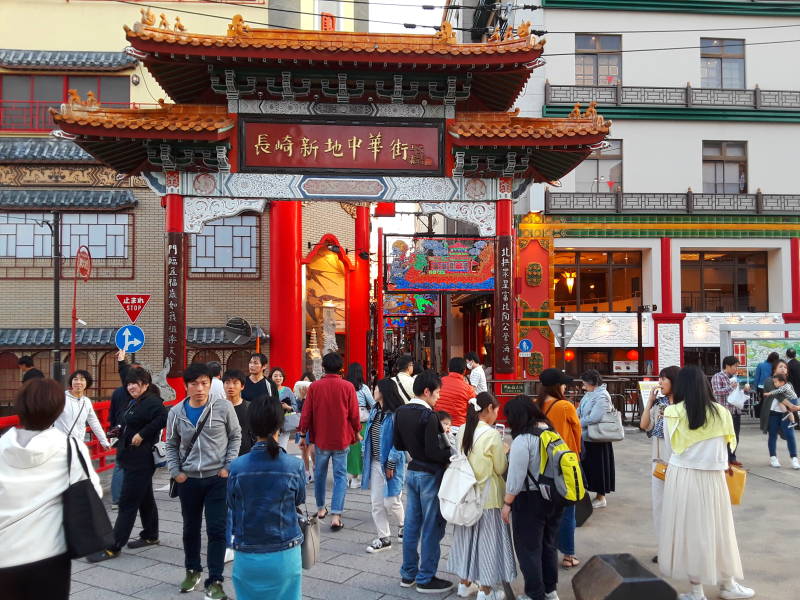
Many of the Chinese merchants came from Fuzhou in Fujian province. They were supposed to stay within this closed area. They weren't as strictly controlled as the Dutch, as long as they were back within Chinatown at night they were OK.
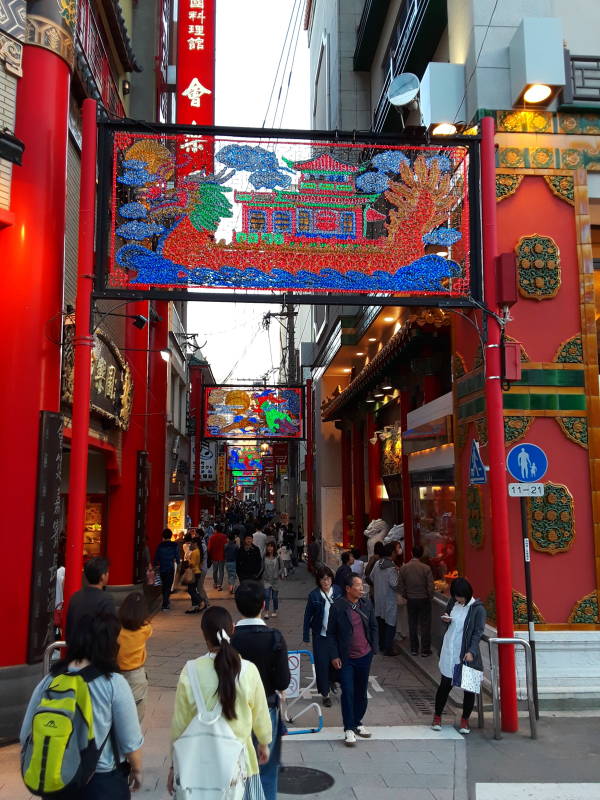
Next, I'll visit a World War II bunker.
The above is specific to Nagasaki. Or maybe you want to explore other places in Japan.

